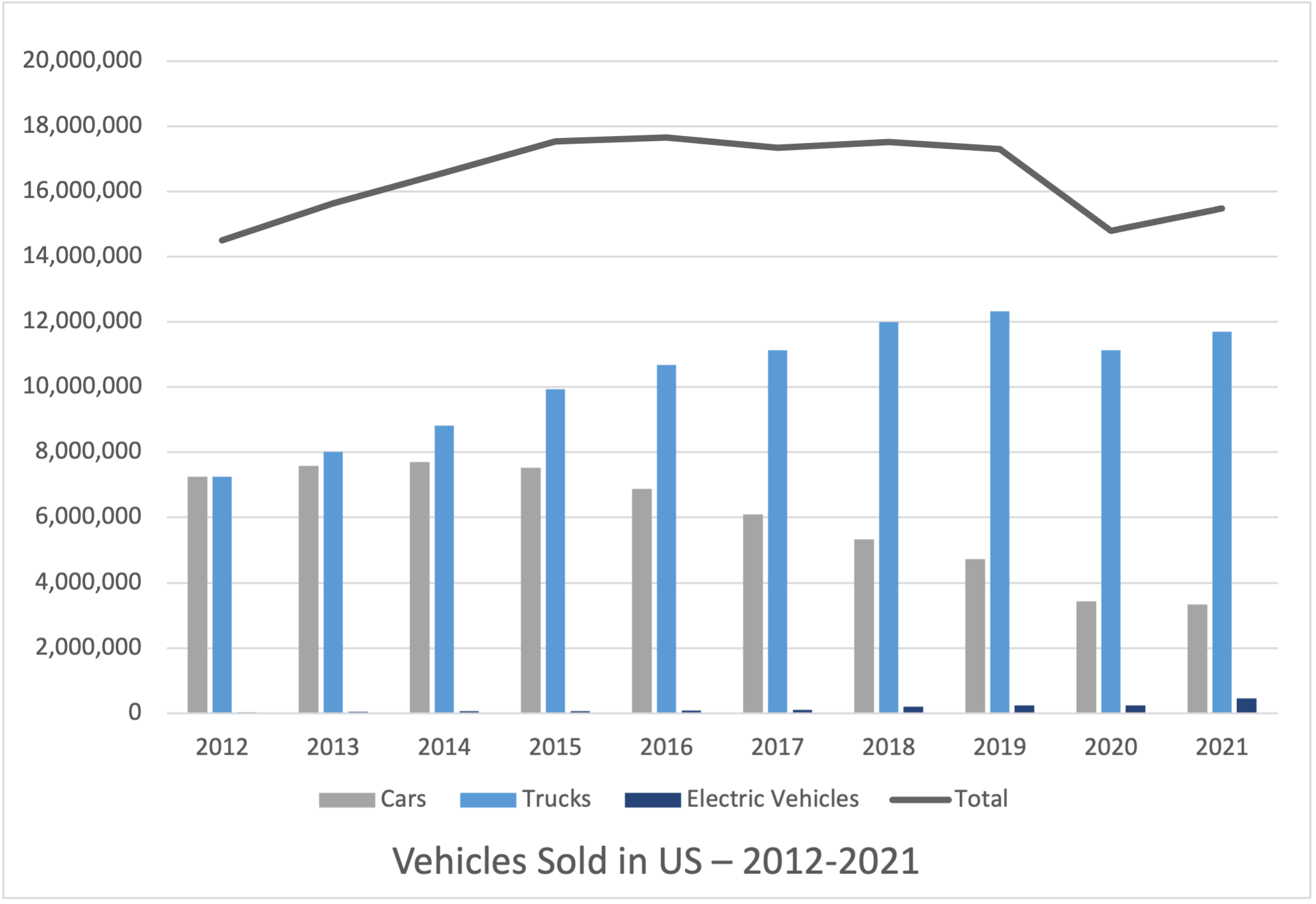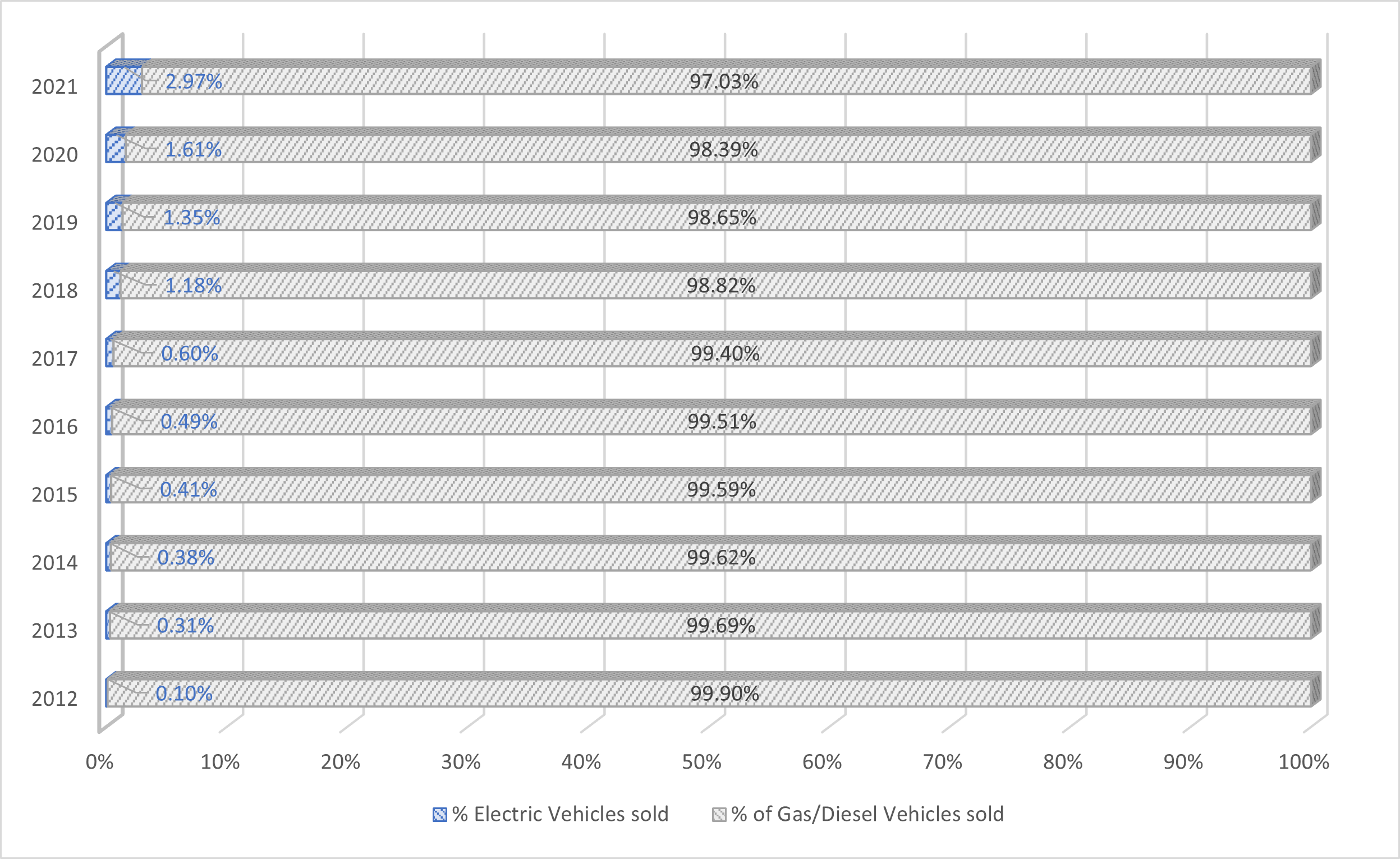Electric Vehicles Are Charging Ahead

At the beginning of automotive history, cars on the road were evenly split between gasoline powered, steam powered, and electric powered vehicles. However, limited electricity availability and the success of Henry Ford’s assembly line strategy led to gasoline powered vehicles rising in popularity. It wasn’t until technological advances in the early 2000s that battery operated vehicles became a viable competitor to traditional gasoline powered vehicles. Now, automotive manufacturers are looking toward a future focused on electric cars. Today we chat with Spencer Pisczak, President at Premier Development Partners, about the future and impact of electric vehicles.
Can you take us through a brief history of electric vehicles in the US? Why are they rising in popularity?
Let’s start by looking at 10 years of statistics:
You can see that electric vehicles are slowly starting to gain market share. Now, let’s see if there is any cost benefit for electric vehicles over gasoline powered ones. Let’s start by comparing the sales price of a Jeep Wrangler to a Jeep Wrangler Hybrid as well as the BMW X5 to the BMW IX.
| Gas Model | Electric Model | Pricing Difference |
|---|---|---|
| Jeep Wrangler $31,195 |
Jeep Wrangler 4xe $54,735 |
$25,540 |
| BMW X5 $57,855 |
BMW IX $87,100 |
$29,245 |
Operational Costs
Electric Vehicles and Hybrids get almost twice as much mileage per “tank” than gas vehicles. Let’s look at the math. The average person drives 13,500 miles per year. In this example we will use 10,000 miles per year. Let’s use $4.00 per gallon as the price for fuel. Both the Jeep and BMW average about 20 miles to the gallon; the BMW is actually a little better. 10,000/20=500 Gallons times $4.00= $2,000 per year for fuel.
On the electric side 10,000/40=250 times $0.15 per kilowatt X 30 kilowatts to fully charge= $1,125 per year for power. So, over a 3-year period the savings total $2,625.
At this point the only electric vehicle we can look at for residual value is a Tesla. The 2018 Tesla Model 3 cost approximately $47,000 and would travel 220 miles with each full charge. That car today sells for an average price of $28,000 being a $19,000 reduction from the original sale price. Let’s look at the price of a new 2018 Jeep wrangler being $34,000 and selling for an average price of $25,000 today, being a $9,000 reduction from the original cost. A loss of $19,000+$2,625 in fuel savings = $16,375 of cost/loss for a Tesla vs a $9,000 cost/loss for a Jeep. Jeep wins with a $7,735 advantage; however, the tax credit below exceeds this savings.
Government Incentives
In 2022 and 2023 the U.S. government provided an extensive incentive to purchase certain hybrid and electric vehicles. That incentive equates to a credit of up to $7,500 per electric vehicle. The credit is based on what county the EVs are made, where their battery components and minerals come from, how much they cost, and how much buyers earn.
Buyers can utilize the Electric Vehicle Savings Finder through the Consumer Reports website to see which vehicles qualify for the tax credit. Many vehicles also qualify for state and local tax incentives. That list can also be found on Consumer Reports website under the EV incentive finder. The IRS has a list of qualifying vehicles, and a list can also be found at fueleconomy.gov.
What Is the Income Limit for the EV Tax Credit?
It’s not just the car—it’s also the buyer. To qualify for a new car tax credit, your household income must have an adjusted gross income of up to $300,000. If you’re filing as head of household, you must earn below $225,000, and individual filers will qualify only with income below $150,000. This provision may not apply if a vehicle is leased.
As more factories for manufacturing both batteries and electric cars are being built, companies are focusing on states such as Kentucky, Georgia, the Carolinas, and Tennessee. Why do you think these southern states are so appealing to these companies?
Companies are investing in the south due to lower unionization rates. Southern states are also offering tax incentives and investment packages to entice companies to their state. Georgia, Tennessee, the Carolinas, and Kentucky are “right-to-work” states, which means a closer wage package for union and non-union companies. Southern states have cheaper land, real estate, and electricity. They also have some of the fastest growing populations.
Where do you see the future of the electric vehicle industry going?
It is hard to say at this point in time. The data shows us that right now the cost advantage of electric vehicles over fuel powered vehicles is minimal, even after factoring in the tax credit. Without the tax credit, the advantage goes to fuel powered vehicles. Much of the development in the EV industry that we currently see is being spurred on due to government subsidies through the Inflation Reduction Act, and we will have to wait and see how much of an impact the government spending has on electric vehicle adaptation.
About the Author
Spencer Pisczak is the President of Premier Development Partners and has over 40 years experience of successfully processing over 1,000 commercial real estate transactions in the disciplines of acquisitions, sales and leasing, development, financing, tax abatement and construction. Spencer has acquired and developed over 1,000 acres, built over 12 business parks, built over 100 buildings totaling in excess of 11 million square feet and exceeding in $600 million in value.



